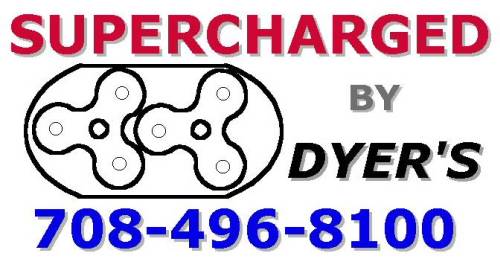
| ENGINE RECOMMENDATIONS
The following are guidelines for building a street application blown engine for use with gasoline. This is basic information that has been compiled over the 30+ years that Dyer's Blowers has been producing street blower kits.
|
|
| Engine Block
Blocks must be in good condition with a maximum of +.060 Bore from stock. Four bolt mains are recommended for high performance applications but two bolt mains can be used in low boost applications. A high performance aftermarket head gasket is recommended for applications up to 12 psi of boost. O-ringing the block is recommended for applications above 12 psi of boost.
A good set of factory high performance heads will provide excellent power on most applications. Stainless Valves and a good 3 angle valve job are recommended for a blown application. Porting and polishing the heads are not necessary in a mild boost application (7-10 psi of boost). Aftermarket high flow heads are recommended on engines producing over 12 psi of boost.
Cast Cranks may be used in low boost applications (5 psi of boost or less). Steel Cranks are recommended in all applications. A factory steel crank will be sufficient for most street applications. Aftermarket 4340 steel cranks are recommended for engines running over 12 psi of boost and/or blown engines with nitrous.
All rods should be magnafluxed before use in blown applications. Stock Rods may be used in low boost applications (5 psi of boost or less). Factory High Performance Steel Rods are recommended for most applications. Aftermarket 4340 steel rods are recommended for engines running over 12 psi of boost and/or blown engines with nitrous.
Factory Cast Pistons may be used in low boost applications (under 5 psi of boost). Forged low compression pistons (7.0-1 to 8.0-1) with press fit pins are recommended for applications up to 12 psi of boost. Higher compression pistons may cause detonation and heating problems and are not recommended on gasoline applications. In applications over 12 psi of boost, an aftermarket low compression piston with full floating pins and double spiral locks are recommended.
A good set of moly rings are recommended in most applications. Aftermarket gapless rings are recommended in high boost applications.
A mild hydraulic cam is recommended in mild boost applications (7-10 psi). Specs are .500" lift, 280 advertised duration (235@.050) and 112 lobe center. We also recommend using the top springs and highest seat pressure that is recommended by the cam manufacturer. On high boost applications, we recommend a solid lifter or roller cam. We recommend contacting a cam manufacturer of your choice for high boost cam and spring specifications.
On most applications, we recommend using a pair of Holley 750 Double Pumper Carbs (Model#4779). These will work fine in stock condition on engines under 500 inches. A polished version of this carb is Holley Model#80573. These carbs will need to be mounted side saddle and require side mount fuel lines and linkage.
An ideal distributor has 9 degrees mechanical advance in it (18 degrees at the crankshaft). We recommend starting the advance at 1200 rpms and have full advance at 3000 rpms. In most cases, small block V8's run 34-36 degrees of total advance for street applications. With 36 degrees total, the initial should be 18 degrees at idle and will advance to 36 degrees above 3000 rpms.
Ignition system that utilize the boost/retard feature are not necessary but may provide insurance against detonation. With moderate boost levels and proper fuel octane, detonation can be avoided without retarding the timing. However, when availability of correct fuel or in some street/strip applications, the boost/retard systems can prevent detonation and engine damage.
|